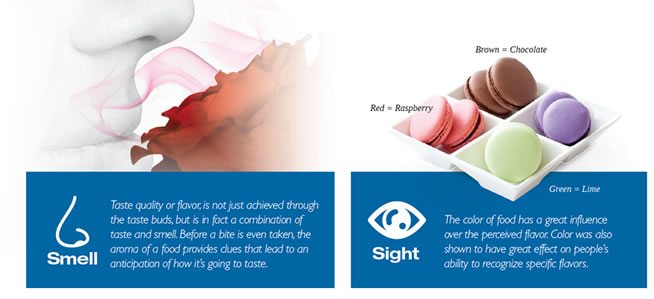To clear the air once and for all, it’s true, “you eat with your eyes.” Consumers make a subconscious decision the instant they see or smell food about how much they anticipate enjoying the taste. However, sometimes these perceptions can be misleading. More often than not, patrons are influenced by pictures on the menu and in restaurants, but find what’s placed in front of them is lacking the aesthetics that lured them to order in the first place. Looks can be deceiving, primarily based on the fact that taste and flavor are actually perceptions of the mind influenced by a number of factors, from scent, to texture, to color to presentation.
The sense of taste is very complex and just one way that we experience food. The National Institute of Health explains that the ability to taste happens when tiny molecules, released when we chew or drink, stimulate sensory cells in the mouth and throat. These taste cells are clustered within taste buds on the roof of the mouth, the tongue and on the lining of the throat. When these cells are stimulated, they send messages through nerves to the brain, which is where specific tastes are finally identified. The taste cells have receptors that respond to at least one of five basic taste qualities: salty, sweet, sour, bitter and umami (or savory).
However, taste quality or flavor, is not just achieved through the taste buds, but is in fact a combination of taste and smell. Before a bite is even taken, the aroma of a food provides clues that lead to an anticipation of how it’s going to taste. Then as you chew, you force air through your nasal passages, carrying the smell of the food along with it. “Without that interplay of taste and smell, you wouldn’t be able to grasp complex flavors,” explains Tom Finger, a professor at the University of Colorado-Denver Medical School. It is due to this connection that when a person loses their sense of smell they find food no longer tastes good.
The texture and mouth-feel of food and drinks are also very important in determining how flavor is perceived. Texture is defined by the physical properties of food based on touch, such as soft or hard, smooth or lumpy and mushy or crunchy. Mouth-feel refers, quite literally, to how food feels inside your mouth due to the chemical and physical interactions that take place. With every bite, the taste receptors detect and react to temperature and composition changes, causing attributes of the flavor to be perceived, for example, minty freshness or heat (spiciness) from peppers. These factors are important when it comes to creating a delicious balance in meals allowing us to enjoy the entire experience.
Yet taste, texture and smell are not the dominant senses when it comes to flavor perception. Charles Spence, head of the Crossmodal Research Laboratory at Oxford University carried out research regarding how sight plays a large role in affecting our perception of flavor. “Half the brain is visual in some sense,” says Spence, “versus just a few percent for overall taste sense. So in cortical real estate, vision is always going to win.” Due to this fact, the color and shape of food and drink not only has a huge role in determining whether it is appetizing, but also its flavor as well. Based on Spence’s observations, shapes can act as symbols influencing our perception of flavor. People tend to match a variety of tastes, such as sweetness, bitterness and sourness; oral attributes, like texture, bubbles and mouth-feel; and flavors to abstract shapes. Typically, round forms are more likely associated with sweetness whereas angular shapes (triangles, squares, stars) are more often associated with bitterness or saltiness. Whether or not people are basing these shape-flavor associations on natural foods, such as berries (round and sweet) or crackers and chips (angular and salty), is yet to be determined.
One of the most significant studies demonstrating the strong link between color, flavor and the pleasure we derive from food was reported by J.C. Wheatley. During his experiment, he had a group of people start eating a meal of steak, French fries and peas in color-masking lighting conditions. Midway through the meal, he restored normal lighting to reveal that they were eating blue-colored steak, green French fries and red peas. According to Wheatley, seeing the actual color of the food was enough to induce nausea in many of the participants. These results hinted at the fact that the color of food has a great influence over the perceived flavor.
Color was also shown to have great effect on people’s ability to recognize specific flavors. In an experiment done by C.N. DuBose, participants were presented with drinks incorporating different color-flavor combinations in which the flavored samples were colored either appropriately, inappropriately or colorless. The results showed that participants’ ability to identify the drinks correctly was significantly influenced by their color. They were less likely to accurately identify the flavor of the inappropriately colored drinks. In fact, almost half of the participants thought that a cherry-flavored drink actually tasted like orange when it was orange-colored, in comparison to zero orange-flavor responses when the drink was colored red. These results are due to the fact that our perceptions are directly related to experience and associations, so naturally knowing that an orange is orange and a cherry is red would lead to the assumptions that the flavor and color are linked.
Eating is not just about taste, but actually a feast for the senses. Flavor is more complex than a food being salty, sweet, sour or bitter. Good chefs know that they need to take all of these factors that contribute to how we perceive flavor into account when creating a dish. If they are able to find a good balance between food that is visually appealing while also having a good taste, scent, texture, color, and shape, then they can actually enhance the flavor as well as the entire dining experience. •••

